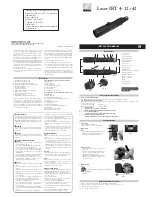
10
(Fig. 11) (Fig. 12)
5) Begin your viewing session by using the 20-mm eyepiece by itself. It will give you
the widest angle and the brightest, sharpest views. To adjust the angle of the
telescope, loosen the tightening screws on either side of the mounting yoke and the
azimuth locking knob (See Fig. 2 on page 4). If you wish to adjust the angle of the
telescope tube vertically in large increments, also loosen the tightening knob that
holds the vertical fine adjustment rod. For fine vertical motions, gradually tighten the
knurled knob on the vertical fine adjustment rod.
When possible, avoid sudden temperature changes, as the moisture in the air will
condense on the mirrors and eyepiece lenses. Should this occur after bringing your
telescope inside, remove the dust caps and allow the moisture to evaporate naturally.
Point the telescope downward to minimize the collection of airborne dust. Once all of
the moisture has evaporated, replace the dust caps.
A NOTE ON TERRESTRIAL VIEWING
You may notice that when you observe a terrestrial subject on land or water it appears
upside down.
To correct this, an image erector is included with your telescope. This accessory is
inserted in the eyepiece holder of the telescope between the eyepiece and the
telescope. With the image erector, objects will appear in their proper orientation for
terrestrial and land observation. NOTE: Do not use the 3X Barlow lens with this
accessory (See Fig. 13).



























